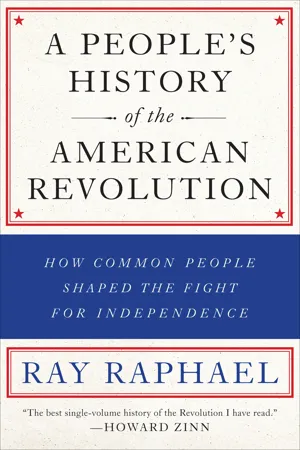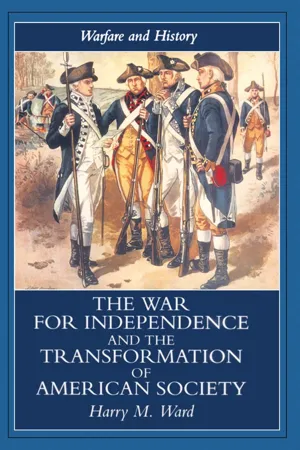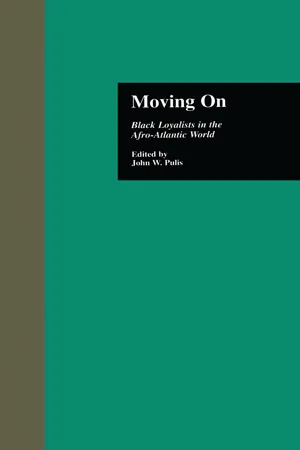History
Loyalists
Loyalists were American colonists who remained loyal to the British Crown during the American Revolutionary War. They opposed the movement for independence and often faced persecution and confiscation of property as a result. After the war, many Loyalists fled to Canada or other British colonies, while others integrated back into American society.
Written by Perlego with AI-assistance
Related key terms
8 Key excerpts on "Loyalists"
- eBook - ePub
A People's History of the American Revolution
How Common People Shaped the Fight for Independence
- Ray Raphael(Author)
- 2011(Publication Date)
- The New Press(Publisher)
It only suggests what we already know: Loyalists were plentiful enough to turn the Revolution into a civil war, but not so numerous as to emerge the victors. The literal definition of a loyalist—“a person who professed a continuing allegiance to the King of Great Britain”—is simultaneously too broad and too narrow. It includes people who passively accepted the legitimate authority of the British government, even though they might not have been willing to act in its defense, while it excludes a good number who contributed to the loyalist cause for self-serving reasons without cherishing any special feelings for monarchy in general or for George III in particular. Contemporary patriots seldom used the term “loyalist,” with its positive connotations; they preferred to call their adversaries “Tories”—a word with a very British ring—often preceded by the adjective “damned.” (Friends of the king, in a similar manner, liked to use the term “rebel,” commonly preceded by the same adjective.) In the patriot vernacular, Tories were said to be “disaffected” to the American cause. Not signing the Association, toasting the king, quartering a British soldier—these were all marks of disaffection. The disaffected included anybody who failed to support the Revolution, even those who tried to stay neutral. Several of the most vocal of the disaffected fit the classic image of the Tory: wealthy conservatives who were obligated to the British government and who felt threatened by republican theory and the rise of the common man. 3 In rural Massachusetts, where the Revolution began, Loyalists came primarily from the ranks of the local elites, people like the Chandlers and Paines of Worcester County and the Williamses and Worthingtons of Hampshire County who had held power under the old order - eBook - ePub
Loyalist Literature
An Annotated Bibliographic Guide to the Writings on the Loyalists of the American Revolution
- Robert S. Allen(Author)
- 1982(Publication Date)
- Dundurn Press(Publisher)
25 The rest of the book summarizes the careers, attitudes and plights of various individual Loyalists, colony by colony during the war. In the epilogue, ‘A Special Kind of Civil War,’ pp. 500-6, Calhoon concludes that the revolution was an effort to discover the legitimate sources of authority within American society. Once again the argument is presented that British policy restricted colonial autonomy and impinged on traditional liberties which forced the colonies to re-examine the nature of the compact between the colonies and the Crown. The ensuing constitutional debate created fierce antagonisms within colonial society and against the royal officials and allies of the Crown. Yet throughout, Loyalist beliefs never coalesced into a common or unified persuasion. The book, by relying on secondary sources, provides a good synthesis of published Loyalist literature.The active and significant contribution of the Loyalists in the military campaigns of the civil war and rebellion in colonial America are detailed in several key sources, many of which focus on Loyalist provincial corps histories. Piers Mackesy, The War of America, 1775-1783 (Cambridge, Mass.: Harvard University Press, 1965) examines general strategy and the Loyalist participation in a scholarly and unbiased manner. Paul H. Smith, Loyalists and Redcoats: A study in British Revolutionary Policy (1964; and New York: W.W. Norton and Co., 1972); and ‘The American Loyalists: Notes on their Organization and Numerical Strength,’ William and Mary Quarterly , Vol. 25, No. 2 (1968), pp. 259-77, argues that the fifty provincial corps of Loyalists which numbered about 10,000 men in arms were not used effectively. Specific details on the various Loyalist provincial units are briefly outlined in the classic, William O. Raymond, ‘Loyalists in Arms,’ New Brunswick Historical Society Collections , No. 5 (1904), pp. 189-223; and in Philip Katcher, The American Provincial Corps, 1775-1784 (Reading, England: Osprey, 1973), and in Elinor Senior, ‘Loyalist Regiments after the American Revolution,’ Canadian Genealogist , Vol. 2, No. 1 (1980), pp. 31-46, with maps. Individual regimental histories include H.M. Jackson, ed., for the late Colonel C.J. Ingles, The Queen’s Rangers in the Revolutionary War (NP, 1956); D.B. Read, The Life and Times of General John Graves Simcoe (Toronto: George Virtue, 1890); Lt.-Col. J.G. Simcoe, Simcoe’s Military Journal: A History of the Operations of a Partisan Corps Called the Queen’s Rangers (New York, 1844; and reprinted Toronto: Baxter, 1962); E. Rae Stuart, ‘Jessup’s Rangers as a Factor in Loyalist Settlement’ in Three History Theses (1939; and Toronto: Ontario Department of Public Records and Archives, 1961); William S. Stryker, The New Jersey Volunteers, Loyalists (Trenton, N.J.: Naar Day and Naar, Book and Job Printers, 1887); and E.A. Cruikshank Butler’s Rangers: The Revolutionary Period (Welland, Ont.: Tribune Printing House, 1893; and reprinted Owen Sound, Ont.: Richardson, Bond and Wright Ltd., 1975); and ‘The King’s Royal Regiment of New York,’ Ontario Historical Society Papers and Records - eBook - ePub
The War for Independence and the Transformation of American Society
War and Society in the United States, 1775-83
- Harry M. Ward(Author)
- 2014(Publication Date)
- Routledge(Publisher)
Most estimates place one-third of Americans as loyalist, one-third on the fence, to be swayed by whomever was winning, and one-third rebel. Persons who decided to adhere to Great Britain faced ostracism, confinement, civil disabilities, and, on rare occasion, death. The easiest way to avoid detection and punishment was to take the patriot loyalty oath, which could be rationalized as a temporary expedient. If willing to keep to themselves, giving an appearance of being neutral and not aiding the enemy in any way, Loyalists experienced relative unmolestation. For overt committal to the British cause there was but little recourse than to flee behind British lines or go into exile.Choosing Sides
Throughout the colonies a variety of Americans had a predilection to side with the British cause. Individuals committed themselves out of conviction or self or group interest. A quantitative study of personal traits finds certain determinants. In comparison to the revolutionaries, Loyalists tended to be older, members of the Anglican Church, more wealthy, holders of better jobs, residents of the east coast who depended on their livelihood from their connections with Great Britain, those who expected gain or protection from crown authority, those who had operations or dealings outside a colony, recent immigrants, those better educated and traveled, those more cosmopolitan in outlook, and those authority-and-order oriented.3 Yet Loyalists came from all walks of life. In Massachusetts, for example, of 300 persons banished in 1778, one-third were professionals, gentlemen, and merchants; one-third farmers; and one-third artisans, laborers, and a few shopkeepers.4 Benjamin Rush, in 1777, differentiated Loyalists according to conduct:There were (1) furious Tories who had recourse to violence, and even to arms, to oppose the measures of the Whigs. (2) Writing and talking Tories. (3) Silent but busy Tories in disseminating Tory pamphlets and newspapers and in circulating intelligence. (4) Peaceable and conscientious Tories who patiently submitted to the measures of the governing powers, and who showed nearly equal kindness to the distressed of both parties during the war… .5While Loyalists were everywhere, they were more concentrated in certain locales, usually in an urban context. Most New Hampshire Loyalists were in Portsmouth. In Massachusetts, most were found in the Boston area, a good many of whom were wealthy merchants, whom Anne Hulton described as too “terrified to submit to the Tyranny of that Power they at first set up.”6 - eBook - ePub
Key to the Northern Country
The Hudson River Valley in the American Revolution
- James M. Johnson, Christopher Pryslopski, Andrew Villani, James M. Johnson, Christopher Pryslopski, Andrew Villani(Authors)
- 2013(Publication Date)
- SUNY Press(Publisher)
UCH HAS BEEN SAID of the importance of New York's Hudson Valley during the war of the American Revolution. As both a natural invasion corridor and the nexus of the Continental Army's primary supply routes, the American and British commands spent much of the war vying for control of the region. However, these campaigns were waged primarily by people from outside the colony, be they garrisoning New England Rebels or invading British troops. To native New Yorkers, the battle for control of the Hudson Valley merely accented a far more local and personal struggle. As the Revolution swept through the colonies, longstanding political divisions in New York merged into the greater conflict between rebellion and loyalty to the crown. The result was the creation of a relatively large, diverse, and powerful Loyalist population within the colony. The American Revolution for many residents of the Hudson Valley was thus first and foremost a civil war.The enormity and bitterness of the ensuing struggles inevitably leads one to ask “Why?” What motivated so many of the region's residents to choose a distant government over their friends and neighbors? An examination of the Loyalists' own words yields an answer. The loyal population of the Hudson Valley was not simply “deluded” or “disaffected,” as they are often described in period accounts; rather, their politics were often determined by strong social forces such as family ties, religious conviction, and a respect for civil obedience, law, and order. Woven through all of these forces was often an interest in the defense or pursuit of profit and property. These forces guided the behavior of the Hudson Valley's Loyalists, and also greatly informed their treatment by their more numerous, and ultimately victorious, Rebel neighbors.The term “Loyalist” describes an American who broke with the sentiments of his or her countrymen and believed that submitting to British rule was the best way to ensure peace and prosperity for the Thirteen Colonies. It is worth noting that many of these reviled “Tories” had taken part in the anti-tax protests of the 1760s and early 1770s, as there were few Americans who supported Parliament's efforts to raise revenue-generating taxes on the Colonies. However, as the anti-tax movement grew more radical, people began questioning not just whether or not Parliament had the right to tax Americans, but whether Britain should rule America in the first place.1 - eBook - ePub
A War of Ideas
British Attitudes to the Wars Against Revolutionary France, 1792–1802
- Emma Vincent Macleod(Author)
- 2019(Publication Date)
- Routledge(Publisher)
The claim that there was a remarkable surge of popular loyalism in the 1790s is not nullified, as some historians have suggested, by the economic tensions of the decade which ensured that general public opinion was unreliable as a source of government support. 5 Loyalists were, by definition, committed activists, at least for part of this decade, if not in all cases for all of it. They sought to defend whatever benefits—political, economic, religious or moral—they perceived the present social order to have conferred upon them against the common menace of Jacobinism and its British sympathisers. 6 French egalitarian principles threatened the British social and political hierarchy which, since they protected private property, Loyalists believed to be advantageous to all but the very bottom ranks of society. These principles were also regarded as being hostile to the Established Churches in Britain and to the Christian religion itself, which upheld the political and social system and consoled those who were least well-off under it. Loyalists, watching events across the Channel, also judged them to be destructive of public order and morality. From the time of the royal proclamation against seditious literature of May 1792, Loyalists began rallying to support the government against domestic radicalism, by means of addresses, letters, pamphlets, newspaper articles and the establishment of hundreds, if not thousands, of Loyal Associations from 20 November 1792. 7 The Loyalists had risen, almost wholly without government intervention, because of the threat to the constitution posed by British radicalism, and they were further galvanized and propelled into the public arena by the exponential increase of the domestic threat caused by French events - eBook - ePub
For King, Constitution, and Country
The English Loyalists and the French Revolution
- Robert Dozier(Author)
- 2021(Publication Date)
- The University Press of Kentucky(Publisher)
CHAPTER IVTHE Loyalists AND THE COLD WAR
On December 9, two weeks before the wave of enthusiasm for founding new societies crested, the Observer optimistically commented that the loyal movement had, “in the course of ONE WEEK, triumphed over the evil machinations of a dangerous and deluded faction, which was too long permitted to disgrace this country.”1 Making allowances for the prematurity of the opinions of the Observer’s lead writer, to a degree he was correct. A victory of sorts was in the making, and before December was out, was rapidly turning into a rout of the enemy. Practically every person active in the political community of England was joining the ranks of the Loyalists. Even Charles James Fox seconded a loyal address at St. George’s Parish. If this kind of activity was the antidote to the “French poison,” a large dose had been administered to the English body politic, and only time would reveal whether or not the patient was on the mend.Moreover, the Loyalists revealed themselves by standing up for the constitution. By all precedents (and consequents, as well) this was an unusual occurrence. Normally, it is the discontented, those who desire change, who speak loudest and are more noticed by historians. In this instance, those who were normally not heard of, those who were satisfied with things as they were and who generally did not have anything to complain of were the chief actors. The loyal movement offers us a rare opportunity to examine the thoughts and to analyze actions and their effects in a different section of society, differently motivated and with different goals. In addition, because the Loyalists were the ultimate victors in the struggle, their influence upon the subsequent course of English history was of greater importance than that of their defeated opponents, and a study of them is imperative for any understanding of what was to transpire in the future.There are limitations to such a study. The chief sources of information about the Loyalists are their declarations and resolutions, either collected by Reeves or published in local newspapers. These relate to but a single event. Loyal activities were only occasionally noted by newspapers or were revealed only in the few minutes forwarded to Reeves. The records of the original society in London are fairly complete but should not be taken as representing the whole movement. In spite of this paucity of information, some definite answers about the Loyalists in general can be ascertained. It is possible, for instance, to know to some degree who they were, why they joined the movement, their chief goals, and some of their methods of achieving them. It is also possible to state with some certainty what they failed to do and what they had no intention of doing. - eBook - ePub
The Revolutionary Age
The Political Death of Loyalists in Revolutionary America
- Timothy Compeau(Author)
- 2023(Publication Date)
- University of Virginia Press(Publisher)
If, as Schivelbusch argues, “the deployment of armies on the battlefield is the classic manifestation of collective self-confidence,” then the Loyalists were deprived of this from the earliest stages of the war. According to Galloway, the rebels “were arrayed in arms by voluntary associations, and there was moreover a regular armed force under the Congress to support them.” In stark contrast, “the Loyalists . .. were without a head, and without weapons.” Throughout the conflict, Loyalists were not effectively employed as soldiers, and those who were often felt insulted at British commanders’ arrogant high-handedness. The Crown’s political ineptitude and military incompetence led to defeat, but this did not lessen the Loyalists’ virtues, according to men like Galloway. 9 The Loyalists had done all they could to uphold their personal honor and remain faithful to the king. The loss was not owing to any deficiency in Loyalist manhood; it resulted from impotent British leadership. The Treaty of Paris, signed by American and British diplomats in 1783, only exacerbated Loyalist feelings of betrayal. Many Loyalists hoped to fight on after the Yorktown disaster in 1781, but the British government and treasury were exhausted. Facing a global conflict against France, Spain, and the Dutch Republic, the British Parliament—and eventually the king—accepted the American victory. 10 The Treaty of Paris recognized American independence, secured fishing rights for American sailors on the Grand Banks, and established generous borders for the new nation. An independent United States was difficult enough for Loyalists to accept, but the fifth article of the treaty struck them as a faithless and cowardly surrender - eBook - ePub
Moving On
Black Loyalists in the Afro-Atlantic World
- John W. Pulis, John W. Pulis(Authors)
- 2013(Publication Date)
- Routledge(Publisher)
Chapter 4Black Loyalists in London after the American RevolutionGretchen Holbrook GerzinaAt the end of the American Revolutionary War, the British evacuated thousands of former slaves to Canada, the West Indies, and England as compensation for their assistance to the Loyalist cause. The 400 or so who went to England found themselves among a large black population, numbering at least 10,000, made up of slaves and former slaves, servants, sailors, and students who were born in England, Africa, and the Americas. By 1783 the black population of Britain had expanded to such an extent that, no matter what their country of origin, they were quite noticeable to all.Their stories were sometimes recorded by whites, but those who could write often recorded their own narratives, and "given the opportunity, most of the eighteenth-century Blacks whose voices we can recover, either directly or through intermediaries, chose a British rather than an American identity."1 Despite their obvious differences from the "English" population, the Afro-British in England adopted the religion, customs, and domestic habits of the English. Although many left England at the end of the century for the newly formed Sierra Leone colony, a number of blacks stayed behind. This chapter tells the story of black Loyalists, among other black inhabitants, in London at the end of the eighteenth century.The Effects of the Somerset Decision on the Afro-British in America
In June 1772, London's Lord Chief Justice Mansfield handed down one of the most misunderstood decisions in English history. Two and a half years earlier, a man named Charles Stewart had returned to London from his job as cashier and paymaster in Boston, Massachusetts, taking with him his slave James Somerset. Somerset served him in London but ran off after 2 years, only to be recaptured and imprisoned on a British ship whose captain had orders to sell him when he reached Jamaica. The English antislavery activist Granville Sharp, who had been searching for a test case to establish the invalidity of slavery in Britain, brought suit against Stewart in a highly publicized case. Mansfield finally ruled in favor of Somerset, but only insofar as he could not be compelled to return to colonial slavery. However, this narrow decision was taken both in England and abroad as abolishing English slavery, and even today 1772 is mistakenly referred to as the date at which this occurred.
Index pages curate the most relevant extracts from our library of academic textbooks. They’ve been created using an in-house natural language model (NLM), each adding context and meaning to key research topics.







